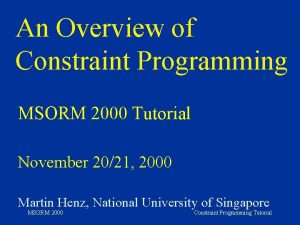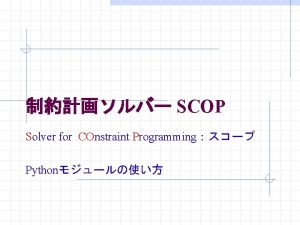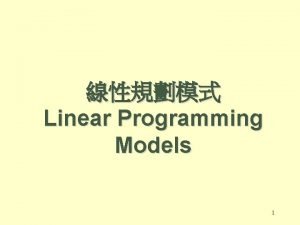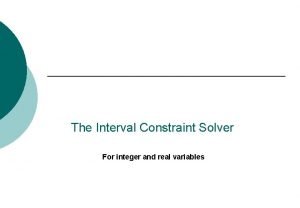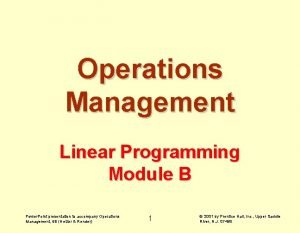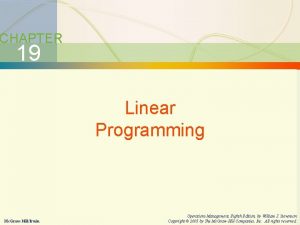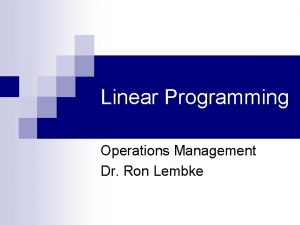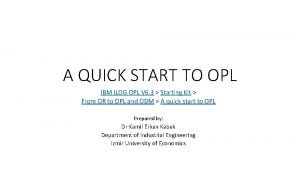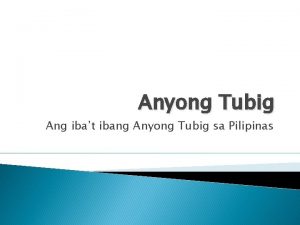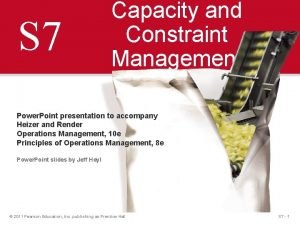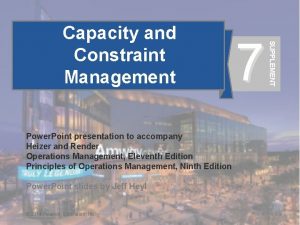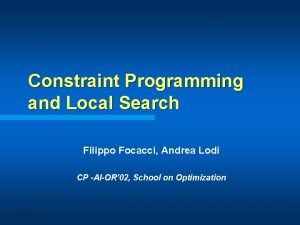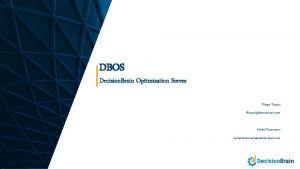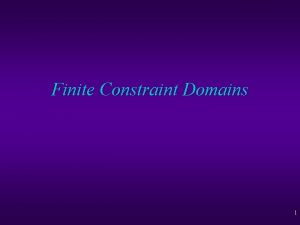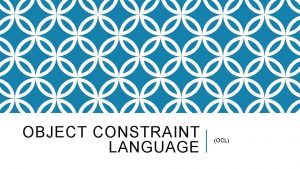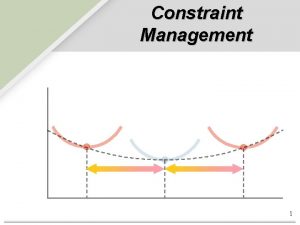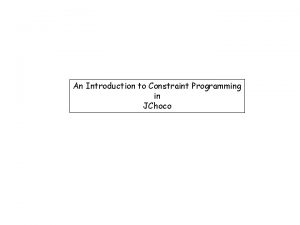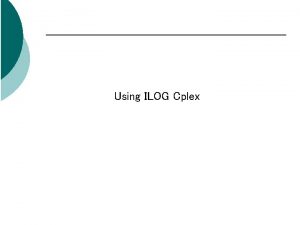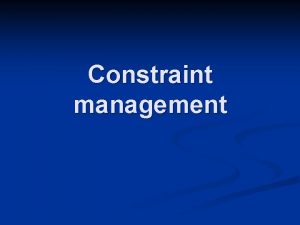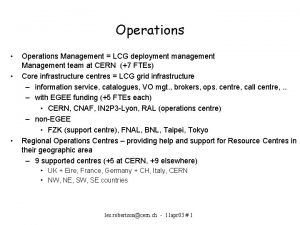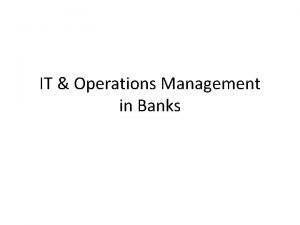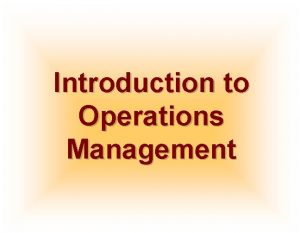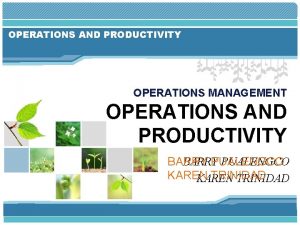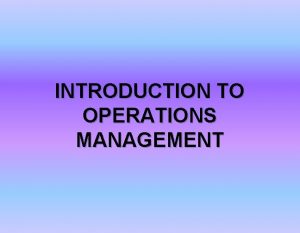Constraint Programming in Operations Management Filippo Focacci ILOG






















- Slides: 22

Constraint Programming in Operations Management Filippo Focacci – ILOG S. A.

Agenda • Constraint-Based Scheduling • Concepts • Constraints • Plant Power. Ops: an industrial application of CP • Introduction • Architecture • Hybrid approach for Integrating planning and scheduling • Integrate business rules in optimization • Demo 2

Constraint-Based Scheduling Introduction • Constraint-Based Scheduling = Scheduling + Constraint Programming • Scheduling problems arise in situations where • A set of activities has to be processed • By a limited number of resources • In a limited amount of time 3

Constraint-Based Scheduling Activities • Non-Preemptive (Interval) Activities Activity A t Start time: s(A) End time: e(A) Processing time: p(A) = e(A) - s(A) 4

Constraint-Based Scheduling Activities • Breakable Activities • Preemption at fixed dates (break calendar) Activity A p 1. . . pi t M T W T F S SM T W T Processing time: p(A) = pi = e(A)-s(A) - breaks(A) 5

Constraint-Based Scheduling Resources • Unary • One person, machine, etc. • Discrete • A group of people with the same capabilities • Energy • A limited number of human-days each week • Reservoir • A stock of raw materials or intermediate products • State • An oven with different possible temperatures 6

Constraint-Based Scheduling Constraints • Temporal constraints • Fixed or variable durations • Precedence constraints • Minimal and maximal delays • Resource constraints • Fixed capacity • Variable capacity (time versus capacity tradeoffs) • Variable capacity over time 7

Constraint-Based Scheduling Constraints • Calendar Constraints • Time intervals during which a resource is not fully available • e. g. , maintenance periods, vacations, forbidden states (at night) • Transition Times • Minimal time required between two activities when in a certain order • e. g. , tool setup between two tasks on the same machine, state change (oven temperature or color used in a painting shop), cleaning, etc. 8

Constraint-Based Scheduling Objective Functions • Examples: • Makespan (max end time) • Sum/max tardiness or earliness • Weighted # of activities • Peak resource usage • Transition times/costs • Weighted # of resources • All possible combinations of the above 9

Constraint-Based Scheduling Resource Constraint Propagation • Several types of global constraints • All make sure the capacity of the resource is not exceeded at any point • Differ in the strength of the propagation they induce: q Explicit timetables Disjunctive constraint q Edge-finding Energetic reasoning q Balance constraint 10

Constraint-Based Scheduling Resource Constraint Propagation • In general, more propagation = more effort • The best propagation algorithm depends • On the application • On the resources within a given application (number of activities, resource criticality, …) 11

Constraint-Based Scheduling Timetables • Identify activities A for which eet(A) > lst(A) • Between lst(A) and eet(A) we know A will be executed 12

Constraint-Based Scheduling Timetables q Q Aggregated necessary demand QMAX t 13

Constraint-Based Scheduling Edge-Finding B p=4 6 C p=5 7 16 15 A A p=2 C p=5 15 7 4 6 16 16 4 7 14

Constraint-Based Scheduling Edge-Finding: Unary Resources • Basic Concept • Prove that an activity A executes before (or after) a set of other activities W. • Jackson's Preemptive Schedule [Pinson 88] [Carlier & Pinson 90/94] • O(n 2) O(n*log(n)) • Iterative algorithm [Nuijten 94] [Martin 96] • O(n 2) with no specific data structure • Task intervals [Caseau & Laburthe 94] • O(n 3) • Incremental 15

Plant Power. Ops Problem Description • Manufacturing planning and scheduling requirements • Continuous production • Determine how to adjust to demand by varying output • Production with co-products and by-products • Determine how to adapt to demand by adjusting the product mix • Campaign and batch production • Determine how to meet demand by determining the length of campaigns, while avoiding costly setups • Industry specific complex constraints • Complex setups, trimming, business policies • Planning and scheduling horizons • Short term – hours to days – re-scheduling and connection with MES • Medium term – days to weeks – integrated planning and scheduling • Long term – weeks to months – planning, what-if analysis 16

Plant Power. Ops Architecture Graphical Planning Board Maintenance & Configuration GUI Planning Plant Floor Engine Parameters Metadata Business Models Middleware • Optimization Development Framework (ODF) from ILOG and SAP • Optimization Extension Kit (OEK) from ILOG and Oracle ODF Reader Planning/IT IT Optimization Algorithms Data Model CSV Reader ODF Writer CSV Writer 17

Plant Power. Ops GUI: Organization Solution Area Problem View Scenario Management Data and Weights Rule Explorer Console 18

Plant Power. Ops Key features • Integrate planning and scheduling • Hybrid CP / MIP • Use business rules to configure and maintain the optimization • Modify the model parameters and data • Add constraints 19

ILOG Plant Power. Ops Integrate Planning and Scheduling Planning engine Data model Planning solution Lot-sizing engine Scheduling Engine Lot-sizing solution Scheduling solution 20

Prepare the Production Schedule Define a rule-based scenario • Activate or deactivate rules and alerts for the current planning or rescheduling scenario 21

Add/Modify Business Policies Define policy rules upon events • Modify the safety stock policy during machine breakdown 22
 Constraint programming tutorial
Constraint programming tutorial Constraint programming python
Constraint programming python Binding constraint linear programming
Binding constraint linear programming Excel solver alldifferent
Excel solver alldifferent Linear programming in operations management
Linear programming in operations management Operations management linear programming
Operations management linear programming Operations management linear programming
Operations management linear programming Webinar ilog cplex
Webinar ilog cplex Ibm ilog opl
Ibm ilog opl Tagpuan ng kabihasnang shang
Tagpuan ng kabihasnang shang Ilog jrules tutorial
Ilog jrules tutorial Mga yamang gubat sa hilagang asya
Mga yamang gubat sa hilagang asya Ito ay anyong tubig
Ito ay anyong tubig Pang abay
Pang abay Webinar ilog cplex
Webinar ilog cplex Capacity and constraint management
Capacity and constraint management Capacity and constraint management
Capacity and constraint management Quadruple constraints in project management
Quadruple constraints in project management Scuola de filippo quarto
Scuola de filippo quarto Dr filippo barbieri pisa
Dr filippo barbieri pisa Licenze poetiche palazzeschi
Licenze poetiche palazzeschi Ic eduardo de filippo sant'egidio del monte albino
Ic eduardo de filippo sant'egidio del monte albino Filippo corridoni
Filippo corridoni
